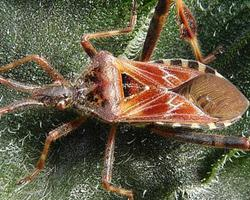
Stav ohrožení
| Ohrožen |
Popis zvířete
The Western conifer seed bug, scientifically named Leptoglossus occidentalis, is a species of true bug belonging to the family Coreidae, commonly known as leaf-footed bugs. This insect is native to the western United States but has expanded its range to eastern North America and across the Atlantic to Europe, where it is often regarded as an invasive species. Its expansion is facilitated by its ability to stow away in human transport vehicles and cargo, as well as its strong flying capabilities which enable long-distance dispersal.Adult Western conifer seed bugs are recognizable by their sizable, elongated bodies, which can reach lengths of up to 2 centimeters (about 0.75 inches). They exhibit a distinctive coloration pattern that blends dark brown hues with patches of lighter brown and orange. One of the most notable features of this species is the leaf-like expansions on the hind legs, which give the bug its common name and aid in identification. These expansions are thought to mimic leaves or other plant parts, possibly providing camouflage against predators.
The head of the Western conifer seed bug is equipped with a robust, piercing-sucking mouthpart, designed for feeding on the sap of conifer trees. Their diet primarily consists of the seeds and cones from a variety of conifer species, including pines, spruces, and firs. By feeding on the sap, they can cause damage to the trees and reduce seed viability, although the impact on healthy, mature trees is typically minimal.
During the warmer months, these bugs are active outdoors, living and breeding in their preferred coniferous habitats. However, as temperatures begin to drop with the approach of winter, Western conifer seed bugs often seek shelter inside buildings and homes, becoming a nuisance to residents. While they do not pose a direct threat to humans or pets and do not damage household structures or fabrics, their presence can be bothersome due to their size, number, and the unpleasant odor they can emit when disturbed or crushed.
The life cycle of the Western conifer seed bug includes egg, nymph, and adult stages. Eggs are laid in the spring, and nymphs emerge and undergo several molts, progressively increasing in size and developing the adult's characteristic appearance. By late summer or early fall, the nymphs have matured into adults, ready to seek winter shelter and repeat the cycle the following year.
In terms of ecological impact, while the Western conifer seed bug is primarily a nuisance pest in human dwellings, its role in its native ecosystem is more complex. As a seed predator, it can influence the reproductive success of conifer trees, potentially affecting forest composition over time. However, the bug also fits into the larger food web, serving as prey for various predators, including birds and spiders.
Given its widespread presence and the challenges it presents, the Western conifer seed bug has attracted attention from both entomologists and pest management professionals. Efforts to manage its populations and mitigate its impact on human activities typically focus on preventing entry into buildings through sealing cracks and openings, rather than chemical control, which is seldom necessary or effective for this particular insect.
In summary, the Western conifer seed bug is a fascinating species whose adaptability and behavior have allowed it to thrive in a wide range of environments. Despite its nuisance status when it invades human spaces, it remains an integral part of the natural ecosystems it inhabits, demonstrating the complex interplay between species and their environments.
Nové fotografie zvířat
Top 10 zvířat
- Chinese water dragon (Physignathus cocincinus)
- Galápagos tortoise (Geochelone nigra complex)
- Dolphin gull (Leucophaeus scoresbii)
- Japanese macaque (Macaca fuscata)
- Colombian red howler (Alouatta seniculus)
- Sea urchins (Echinoidea)
- Moustached guenon (Cercopithecus cephus)
- Diana monkey (Cercopithecus diana)
- Common reed warbler (Acrocephalus scirpaceus)
- Common house mosquito (Culex pipiens)